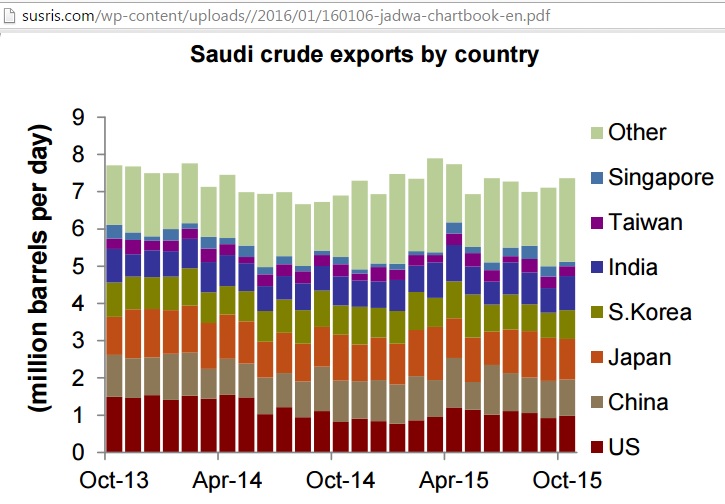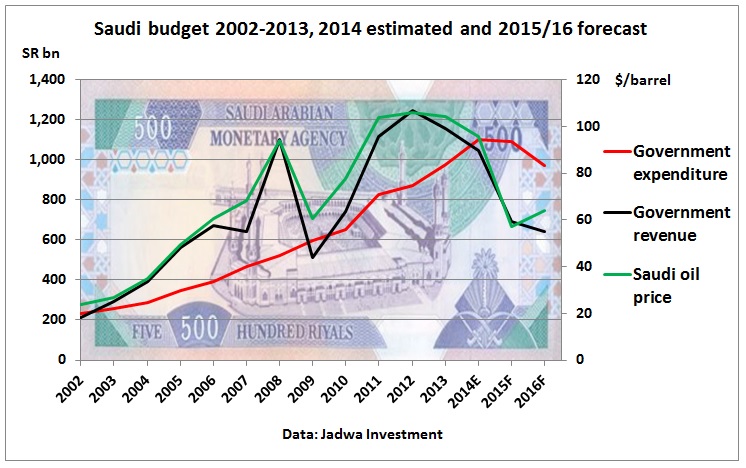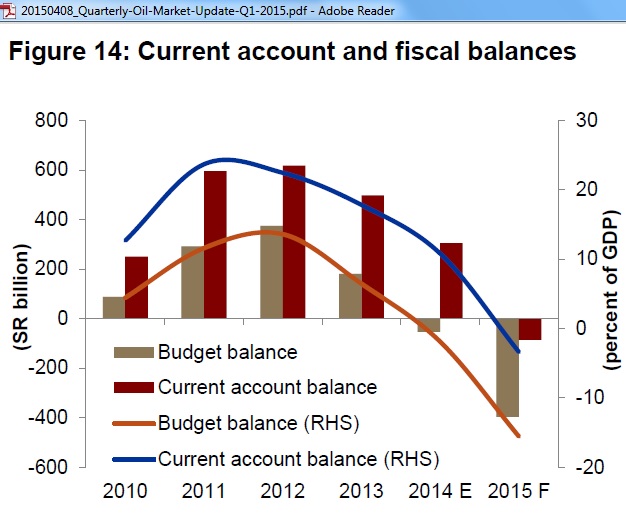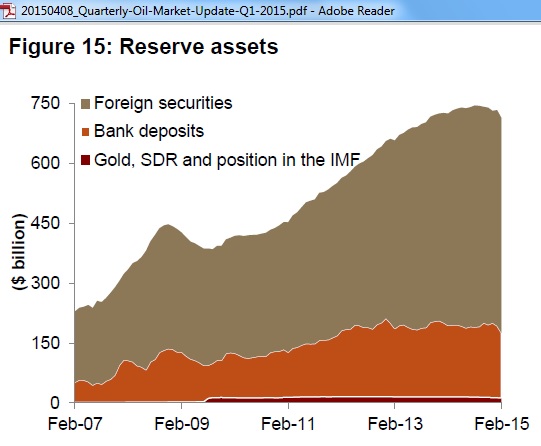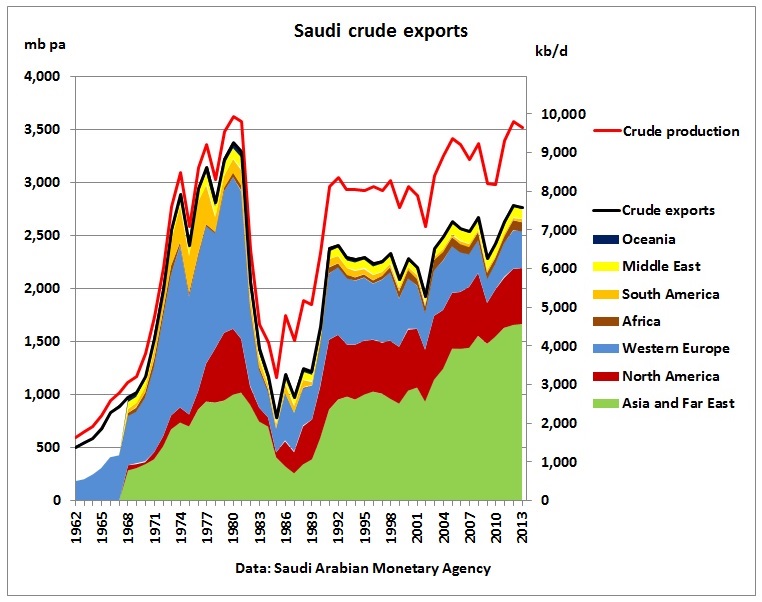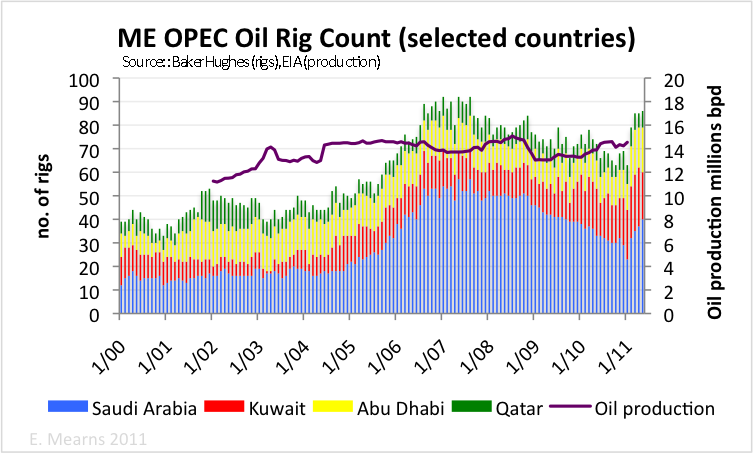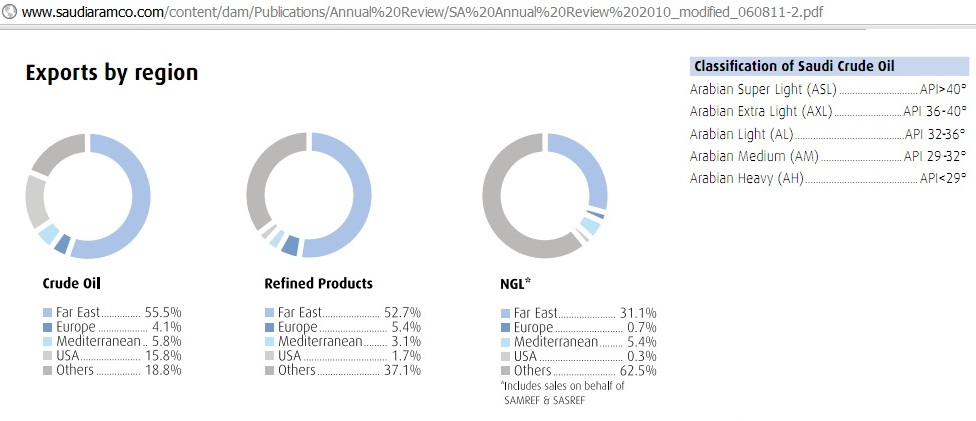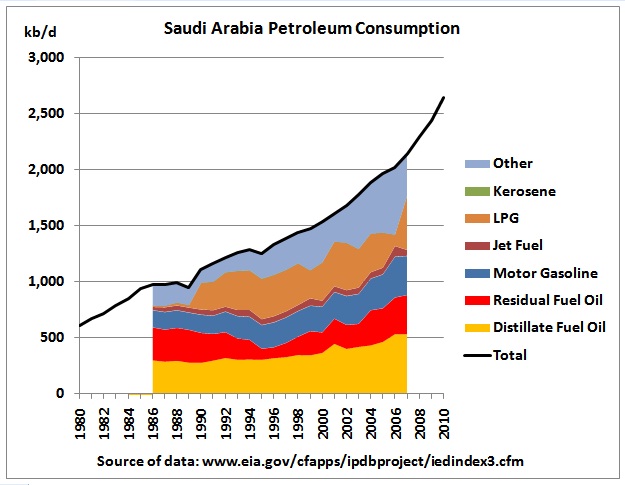Update February 2018

Update January 2016
http://susris.com/wp-content/uploads//2016/01/160126-quarterly-oil-jadwa-en.pdf
Update November 2015
Saudi crude exports meanwhile ran at around 7.4 mb/d from January through August compared to about 7.2 mb/d during the same period in 2014, according to JODI data. Total Saudi oil exports, excluding condensates and NGLs, averaged around 8.4 mb/d during the first eight months of the year versus 8.0 mb/d during the same period in 2014.
https://www.iea.org/media/omrreports/fullissues/2015-11-13.pdf
Update April 2015
From Jadwa Investment
“We believe the government is preparing to start issuing sovereign debt in order to finance the majority of its deficit. This new financing strategy should reduce the pressure on foreign reserves as the main deficit financing tool.”
http://www.jadwa.com/en/download/quarterly-oil-market-update-q1-2015/inflation-report-1-3-2
Update Nov 2014
Update May 2014
2013
Saudi Arabia dramatically increases rig count, accelerates offshore development
16/10/2013
In order to keep up oil export capacity, Saudi Arabia has increasingly sought to replace oil with gas for domestic energy use. As such, a majority of the increase in rig count is dedicated to gas exploration and development. The development of the Manifa field should be seen in this light, as it is set to produce 1.8 bcf/d (51 MMcm/d) of gas. Saudi Aramco recently refocused on development of gas as domestic demand grows.
“Saudi Arabia is the sixth largest oil consumer in the world and this is only set to rise with the kingdom’s population set to increase to 36.5 million by 2032,” said Ruth Lux, managing director of Strategic Analysis. “Current figures suggest 31.5 bbl of oil are burned per person per year and that 33% of domestic oil consumption is used for air conditioning. In the short to medium term, it is unlikely that domestic consumption habits will change. However, Saudi Arabia’s massively subsidized domestic oil consumption is untenably high, and it is not a sustainable energy model for future generations.”
Oil Watch: Drill Baby Drill
30/1/2013
 “The number of rigs operating in the Kingdom reached a record high of 88 in October 2012 and there has to be a message in that statistic in itself. The split was 58 oil and 30 gas. But Saudi Arabia continues to produce around 11.7 million bpd on a slowly rising bumpy plateau with a relatively tiny number of operational rigs. The production world changed in Saudi Arabia in 2005 when the drilling rig count more than doubled, drilling new wells to combat declines from legacy assets like Ghawar. Like the USA, there has been a recent prioritistaion of oil drilling over gas. With Brent crude trading at over $113 / barrel it is quite clear that the world’s major producers are working flat out to meet demand.”
“The number of rigs operating in the Kingdom reached a record high of 88 in October 2012 and there has to be a message in that statistic in itself. The split was 58 oil and 30 gas. But Saudi Arabia continues to produce around 11.7 million bpd on a slowly rising bumpy plateau with a relatively tiny number of operational rigs. The production world changed in Saudi Arabia in 2005 when the drilling rig count more than doubled, drilling new wells to combat declines from legacy assets like Ghawar. Like the USA, there has been a recent prioritistaion of oil drilling over gas. With Brent crude trading at over $113 / barrel it is quite clear that the world’s major producers are working flat out to meet demand.”
http://www.theoildrum.com/node/9795#more
2012
Rig Count
18/3/2012
24/9/2012
Minesweeping exercise near Saudi oil hub
http://crudeoilpeak.info/minesweeping-exercise-near-saudi-oil-hub
2011
27/4/2011
From a slide show by TOTAL (Pierre Mauriaud) at the ASPO 2011 conference
The oil to water content of production is highly different for a carbonate reservoir, where the oil “sticks” to the rock and water is also initially found between the pores. Mauriaud told the audience that when a reservoir is in this case produced too quickly much more water is produced and the oil recovery factor declines. The reason is that the oil can become immobilized once the water front has gone past the pores. In general water production along with the oil in these reservoirs comes very quickly already at the beginning of production, shown in figure 2 for an unnamed Carbonate oil field in the Middle East.
By doing the exercise above in a more detailed manner for various different basins TOTAL found a clear pattern in that all fields begin their decline around 25% to 30% of the oil originally in place (OIIP).
“Whatever the size of the field, you can put Ghawar the biggest field in the world and a very small one together, there is some physical law that after a recovery of about 25% – 30% of the Oil Originally In Place (OIIP) in the reservoir oil production will begin to decrease.”
http://www.theoildrum.com/node/8001
http://www.aspo9.be/assets/ASPO9_Wed_27_April_Mauriaud.pdf
http://www.slideshare.net/tnamgauds/eage-slt-eupmfinal
27/4/2011
OPEC report: Saudi oil exports to decline
http://crudeoilpeak.info/opec-report-saudi-oil-exports-to-decline
2/3/2011
WikiLeaks cable from Riyadh implied Saudis could pump only 9.8 mb/d in 2011
http://crudeoilpeak.info/wikileaks-cable-from-riyadh-implied-saudis-could-pump-only-9-8-mbd-in-2011
2010
Saudi crude production and exports stayed flat between 2009 and 2010
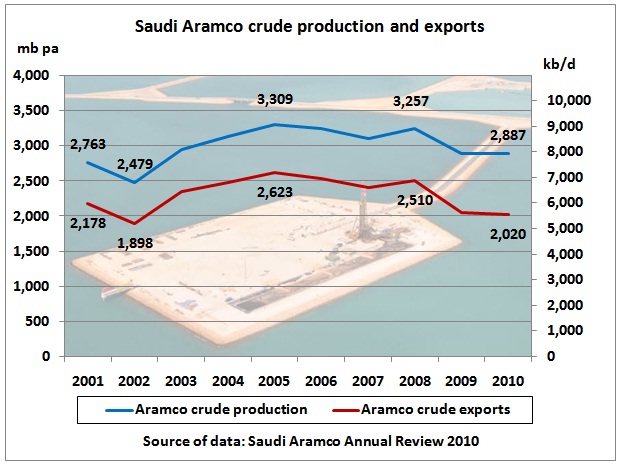 The background picture shows the Manifa heavy oil field on artificial islands still under construction.
The background picture shows the Manifa heavy oil field on artificial islands still under construction.
Saudi Arabia sees full capacity at Manifa oil field by 2014
http://www.energy-pedia.com/article.aspx?articleid=145739
The data for the above graph are from Saudi Aramco’s reports
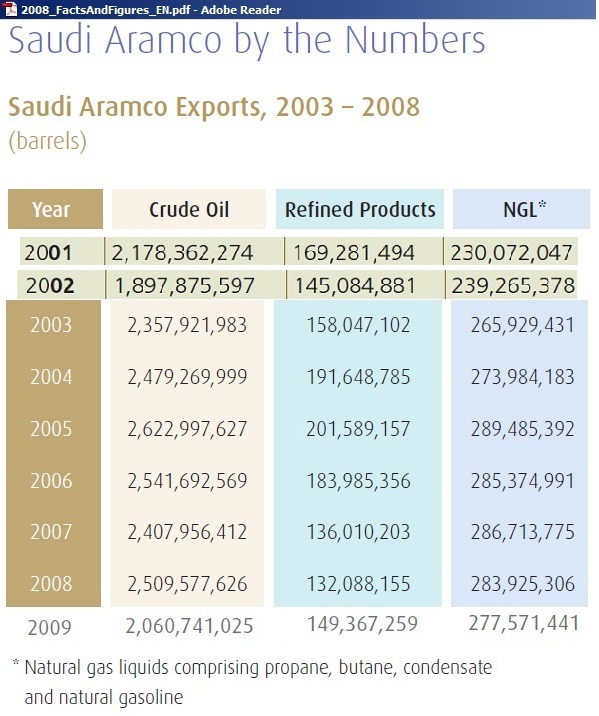 In the above, numbers for 2001, 2002 and 2009 have been pasted into the 2008 report. This is the 2010 Annual Review:
In the above, numbers for 2001, 2002 and 2009 have been pasted into the 2008 report. This is the 2010 Annual Review:

2004
28/4/2004
Mr Al-Naimi [Saudi Oil Minister] said: “Saudi Arabia continues to be committed to OPEC’s $22-28 price band. There are signs that worldwide inventories have begun to build but no one really knows for sure. I do not believe there is a fissure [within Opec]. There is dialogue. Opec in general is committed to the band,” he said.
